LAND ROVER FREELANDER 2001 Workshop Manual
Manufacturer: LAND ROVER, Model Year: 2001, Model line: FREELANDER, Model: LAND ROVER FREELANDER 2001Pages: 1007, PDF Size: 23.47 MB
Page 771 of 1007
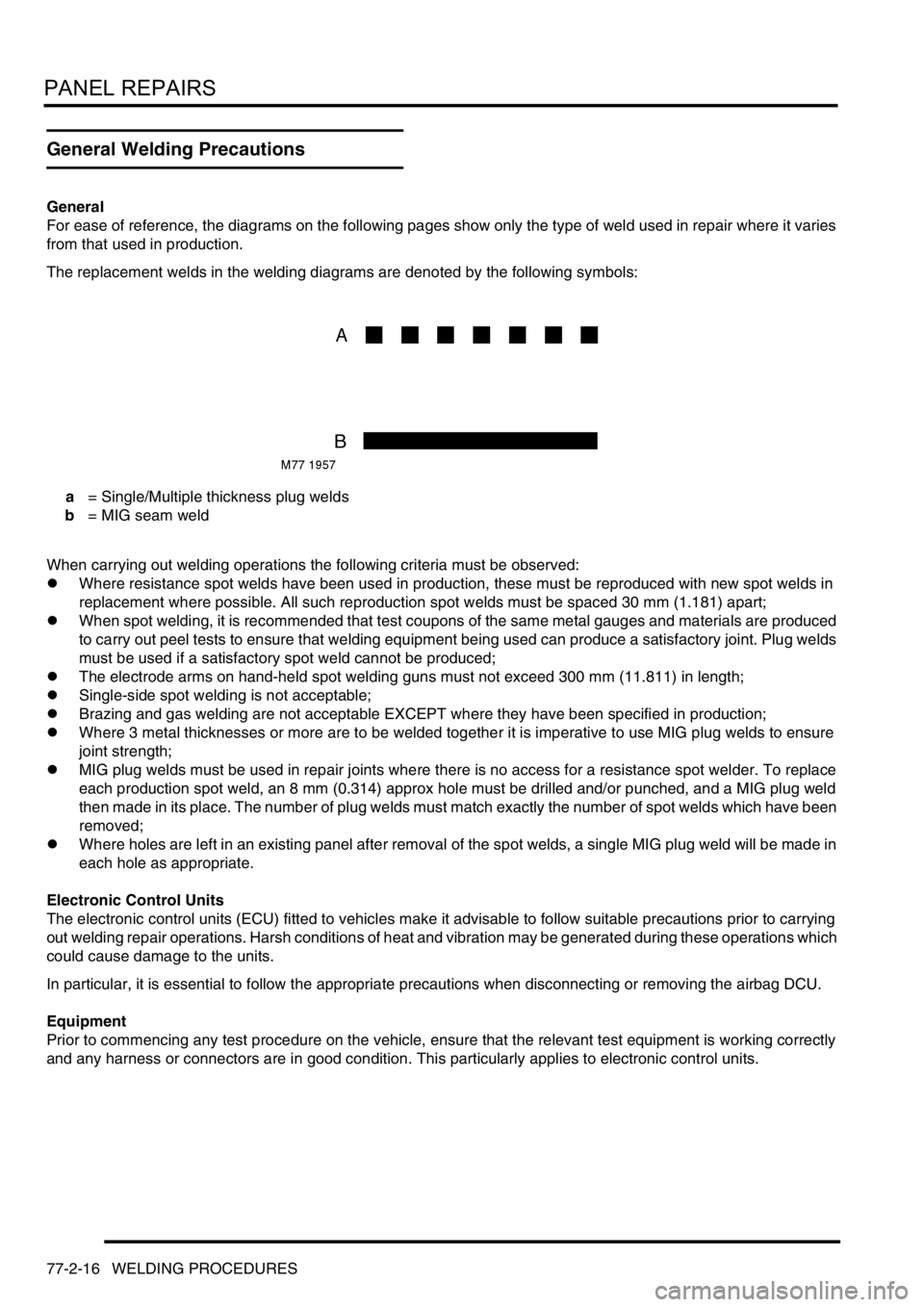
PANEL REPAIRS
77-2-16 WELDING PROCEDURES
General Welding Precautions
General
For ease of reference, the diagrams on the following pages show only the type of weld used in repair where it varies
from that used in production.
The replacement welds in the welding diagrams are denoted by the following symbols:
a = Single/Multiple thickness plug welds
b = MIG seam weld
When carrying out welding operations the following criteria must be observed:
lWhere resistance spot welds have been used in production, these must be reproduced with new spot welds in
replacement where possible. All such reproduction spot welds must be spaced 30 mm (1.181) apart;
lWhen spot welding, it is recommended that test coupons of the same metal gauges and materials are produced
to carry out peel tests to ensure that welding equipment being used can produce a satisfactory joint. Plug welds
must be used if a satisfactory spot weld cannot be produced;
lThe electrode arms on hand-held spot welding guns must not exceed 300 mm (11.811) in length;
lSingle-side spot welding is not acceptable;
lBrazing and gas welding are not acceptable EXCEPT where they have been specified in production;
lWhere 3 metal thicknesses or more are to be welded together it is imperative to use MIG plug welds to ensure
joint strength;
lMIG plug welds must be used in repair joints where there is no access for a resistance spot welder. To replace
each production spot weld, an 8 mm (0.314) approx hole must be drilled and/or punched, and a MIG plug weld
then made in its place. The number of plug welds must match exactly the number of spot welds which have been
removed;
lWhere holes are left in an existing panel after removal of the spot welds, a single MIG plug weld will be made in
each hole as appropriate.
Electronic Control Units
The electronic control units (ECU) fitted to vehicles make it advisable to follow suitable precautions prior to carrying
out welding repair operations. Harsh conditions of heat and vibration may be generated during these operations which
could cause damage to the units.
In particular, it is essential to follow the appropriate precautions when disconnecting or removing the airbag DCU.
Equipment
Prior to commencing any test procedure on the vehicle, ensure that the relevant test equipment is working correctly
and any harness or connectors are in good condition. This particularly applies to electronic control units.
Page 772 of 1007
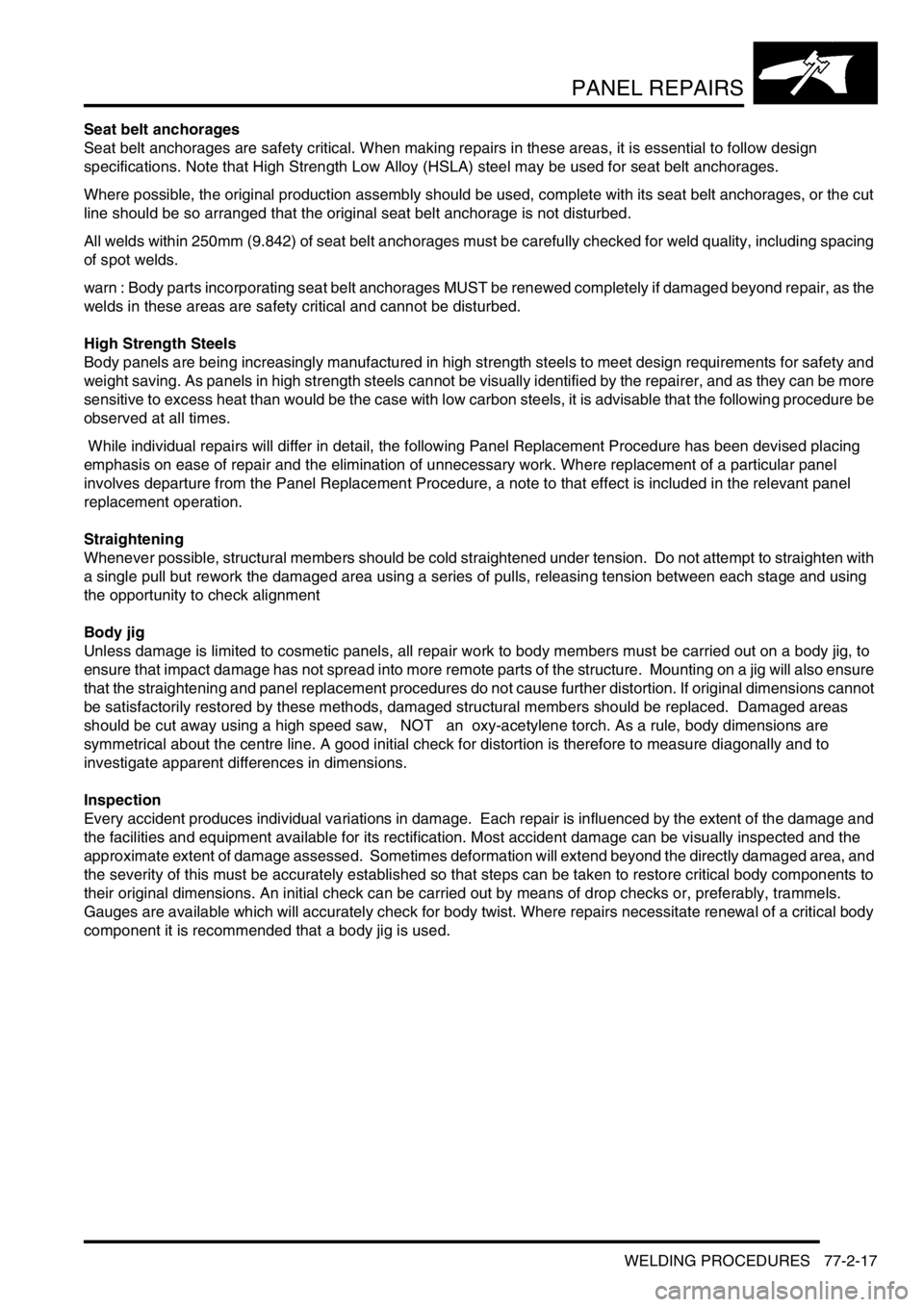
PANEL REPAIRS
WELDING PROCEDURES 77-2-17
Seat belt anchorages
Seat belt anchorages are safety critical. When making repairs in these areas, it is essential to follow design
specifications. Note that High Strength Low Alloy (HSLA) steel may be used for seat belt anchorages.
Where possible, the original production assembly should be used, complete with its seat belt anchorages, or the cut
line should be so arranged that the original seat belt anchorage is not disturbed.
All welds within 250mm (9.842) of seat belt anchorages must be carefully checked for weld quality, including spacing
of spot welds.
warn : Body parts incorporating seat belt anchorages MUST be renewed completely if damaged beyond repair, as the
welds in these areas are safety critical and cannot be disturbed.
High Strength Steels
Body panels are being increasingly manufactured in high strength steels to meet design requirements for safety and
weight saving. As panels in high strength steels cannot be visually identified by the repairer, and as they can be more
sensitive to excess heat than would be the case with low carbon steels, it is advisable that the following procedure be
observed at all times.
While individual repairs will differ in detail, the following Panel Replacement Procedure has been devised placing
emphasis on ease of repair and the elimination of unnecessary work. Where replacement of a particular panel
involves departure from the Panel Replacement Procedure, a note to that effect is included in the relevant panel
replacement operation.
Straightening
Whenever possible, structural members should be cold straightened under tension. Do not attempt to straighten with
a single pull but rework the damaged area using a series of pulls, releasing tension between each stage and using
the opportunity to check alignment
Body jig
Unless damage is limited to cosmetic panels, all repair work to body members must be carried out on a body jig, to
ensure that impact damage has not spread into more remote parts of the structure. Mounting on a jig will also ensure
that the straightening and panel replacement procedures do not cause further distortion. If original dimensions cannot
be satisfactorily restored by these methods, damaged structural members should be replaced. Damaged areas
should be cut away using a high speed saw, NOT an oxy-acetylene torch. As a rule, body dimensions are
symmetrical about the centre line. A good initial check for distortion is therefore to measure diagonally and to
investigate apparent differences in dimensions.
Inspection
Every accident produces individual variations in damage. Each repair is influenced by the extent of the damage and
the facilities and equipment available for its rectification. Most accident damage can be visually inspected and the
approximate extent of damage assessed. Sometimes deformation will extend beyond the directly damaged area, and
the severity of this must be accurately established so that steps can be taken to restore critical body components to
their original dimensions. An initial check can be carried out by means of drop checks or, preferably, trammels.
Gauges are available which will accurately check for body twist. Where repairs necessitate renewal of a critical body
component it is recommended that a body jig is used.
Page 773 of 1007

Page 774 of 1007
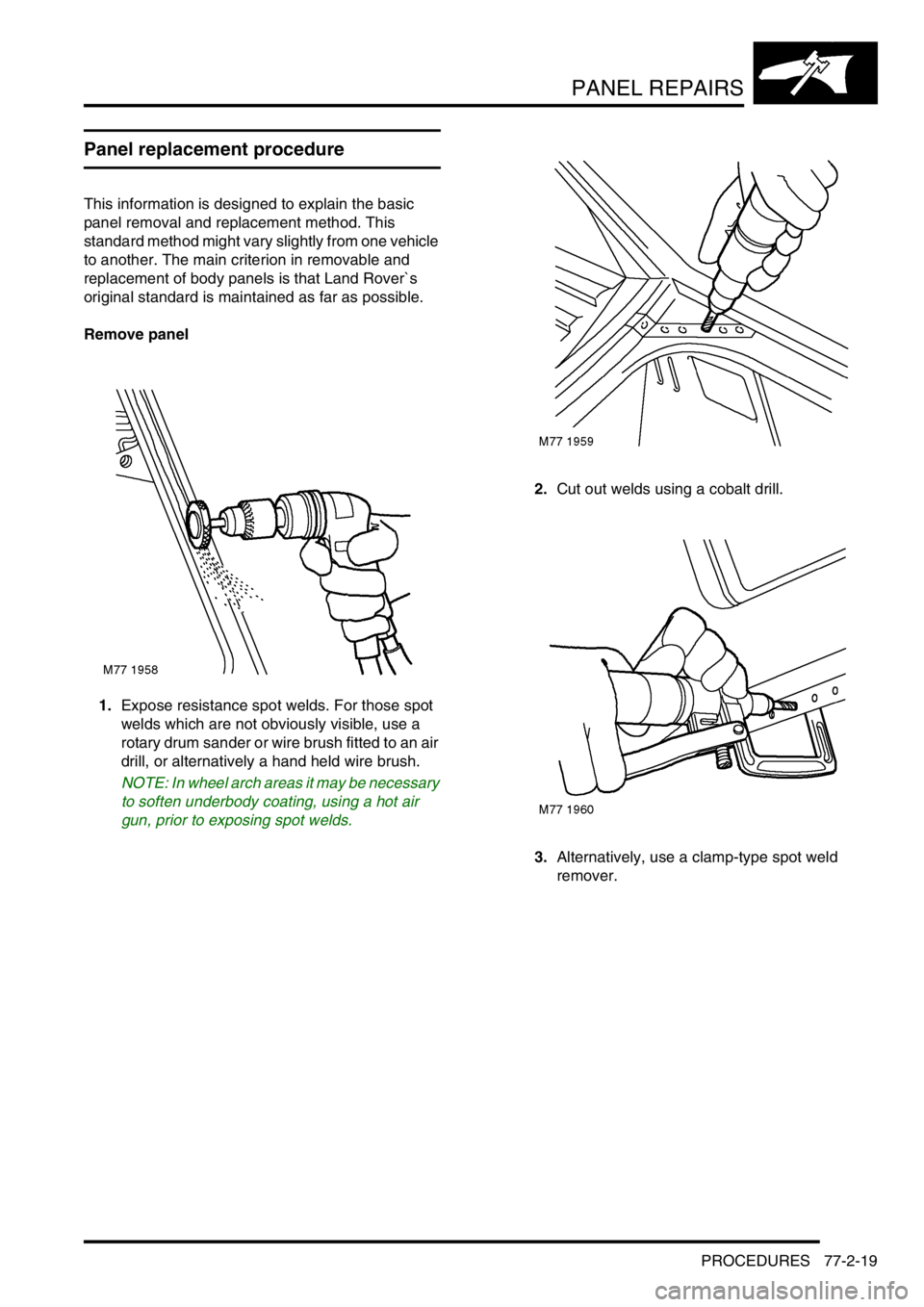
PANEL REPAIRS
PROCEDURES 77-2-19
PROCEDURES
Panel replacement procedure
This information is designed to explain the basic
panel removal and replacement method. This
standard method might vary slightly from one vehicle
to another. The main criterion in removable and
replacement of body panels is that Land Rover`s
original standard is maintained as far as possible.
Remove panel
1.Expose resistance spot welds. For those spot
welds which are not obviously visible, use a
rotary drum sander or wire brush fitted to an air
drill, or alternatively a hand held wire brush.
NOTE: In wheel arch areas it may be necessary
to soften underbody coating, using a hot air
gun, prior to exposing spot welds.2.Cut out welds using a cobalt drill.
3.Alternatively, use a clamp-type spot weld
remover.
Page 775 of 1007
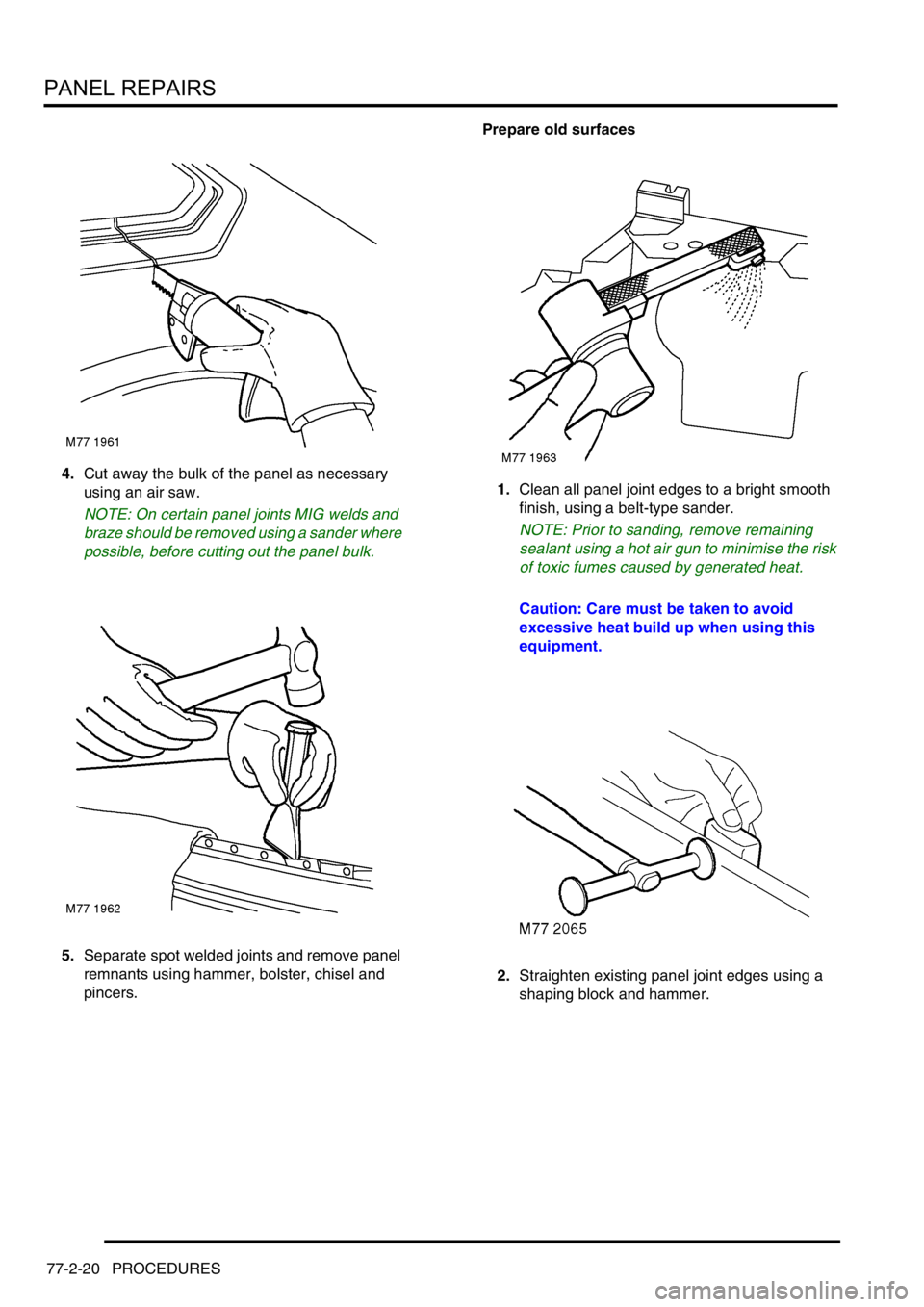
PANEL REPAIRS
77-2-20 PROCEDURES
4.Cut away the bulk of the panel as necessary
using an air saw.
NOTE: On certain panel joints MIG welds and
braze should be removed using a sander where
possible, before cutting out the panel bulk.
5.Separate spot welded joints and remove panel
remnants using hammer, bolster, chisel and
pincers.Prepare old surfaces
1.Clean all panel joint edges to a bright smooth
finish, using a belt-type sander.
NOTE: Prior to sanding, remove remaining
sealant using a hot air gun to minimise the risk
of toxic fumes caused by generated heat.
Caution: Care must be taken to avoid
excessive heat build up when using this
equipment.
2.Straighten existing panel joint edges using a
shaping block and hammer.
Page 776 of 1007
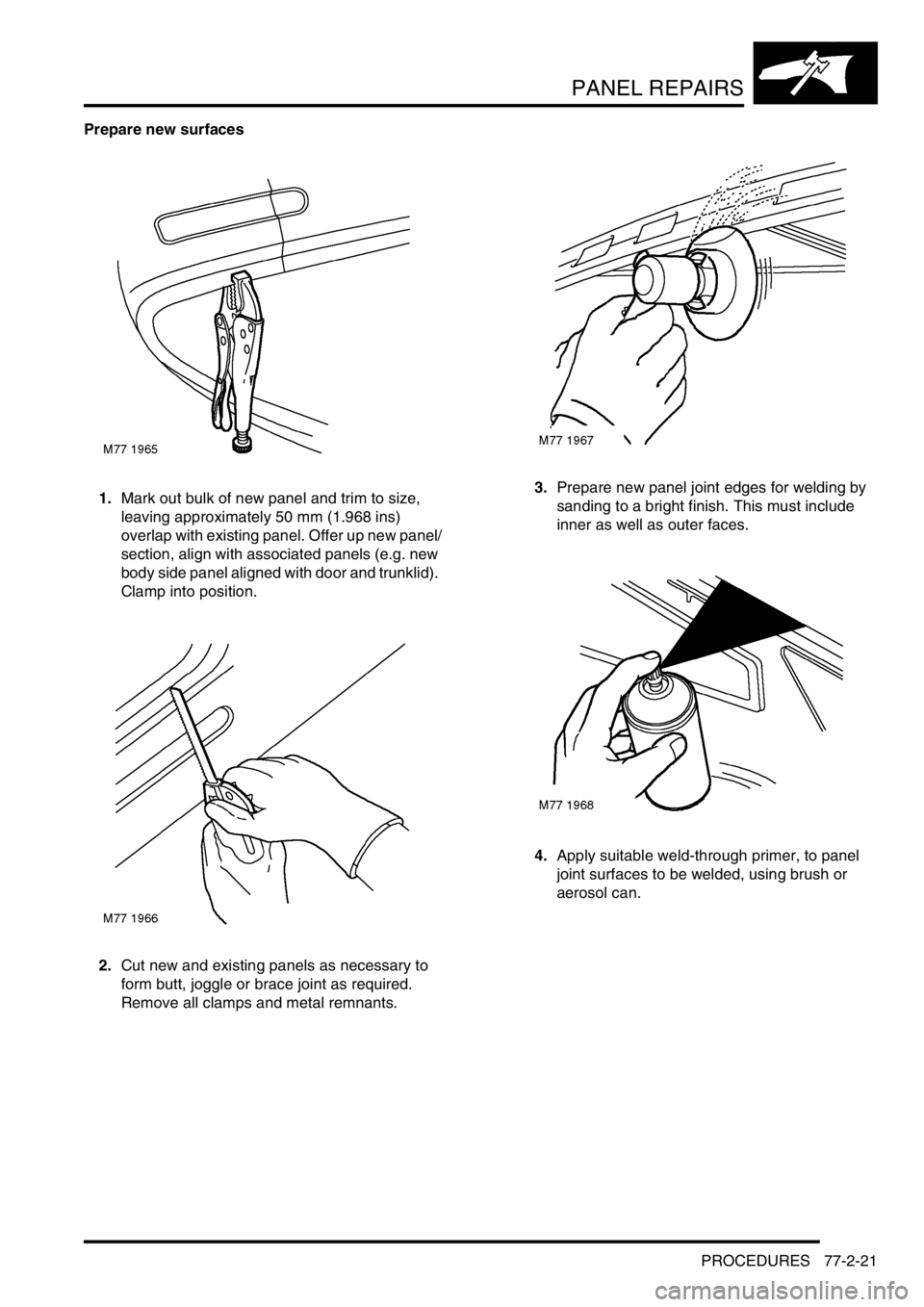
PANEL REPAIRS
PROCEDURES 77-2-21
Prepare new surfaces
1.Mark out bulk of new panel and trim to size,
leaving approximately 50 mm (1.968 ins)
overlap with existing panel. Offer up new panel/
section, align with associated panels (e.g. new
body side panel aligned with door and trunklid).
Clamp into position.
2.Cut new and existing panels as necessary to
form butt, joggle or brace joint as required.
Remove all clamps and metal remnants.3.Prepare new panel joint edges for welding by
sanding to a bright finish. This must include
inner as well as outer faces.
4.Apply suitable weld-through primer, to panel
joint surfaces to be welded, using brush or
aerosol can.
Page 777 of 1007
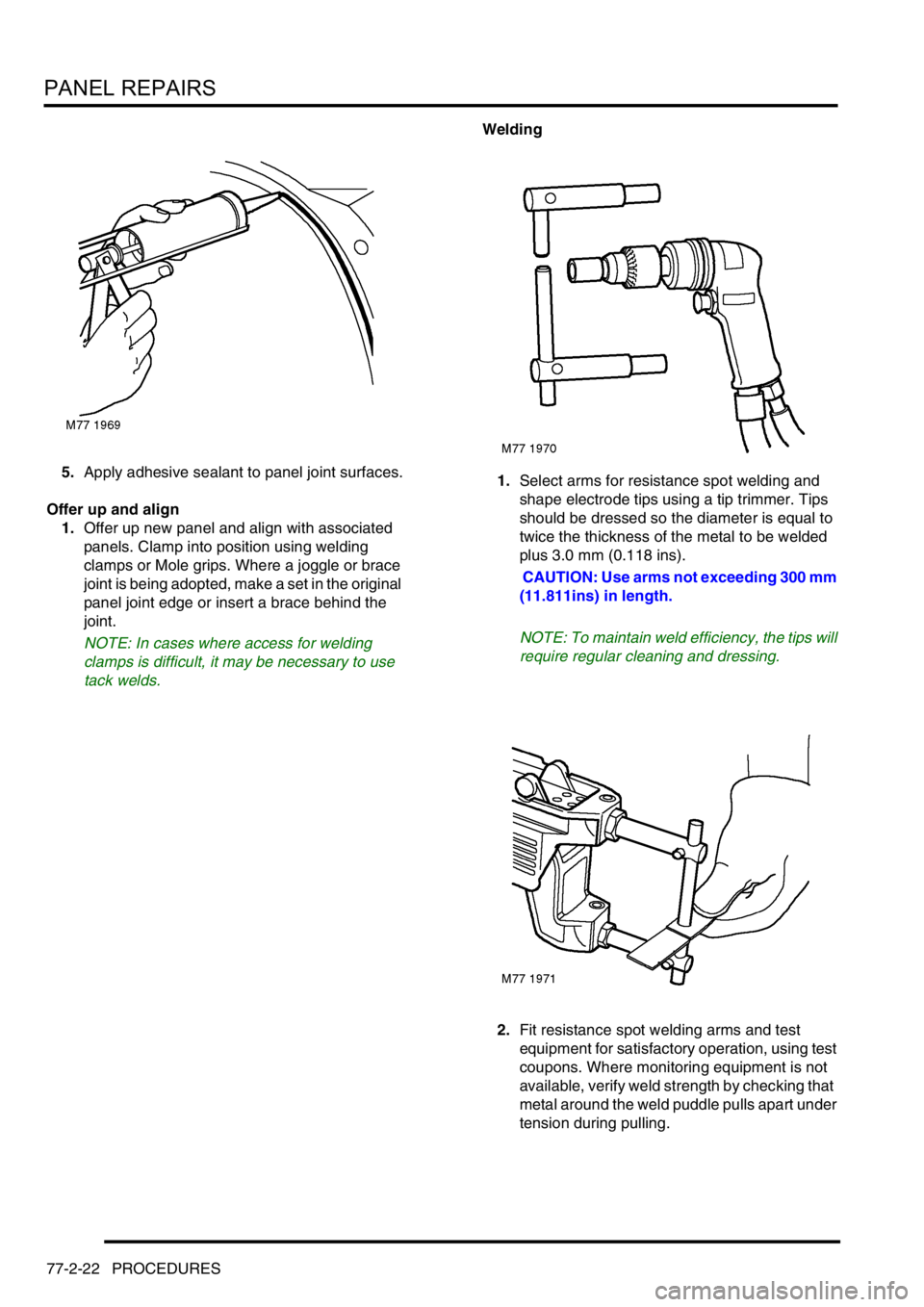
PANEL REPAIRS
77-2-22 PROCEDURES
5.Apply adhesive sealant to panel joint surfaces.
Offer up and align
1.Offer up new panel and align with associated
panels. Clamp into position using welding
clamps or Mole grips. Where a joggle or brace
joint is being adopted, make a set in the original
panel joint edge or insert a brace behind the
joint.
NOTE: In cases where access for welding
clamps is difficult, it may be necessary to use
tack welds.Welding
1.Select arms for resistance spot welding and
shape electrode tips using a tip trimmer. Tips
should be dressed so the diameter is equal to
twice the thickness of the metal to be welded
plus 3.0 mm (0.118 ins).
CAUTION: Use arms not exceeding 300 mm
(11.811ins) in length.
NOTE: To maintain weld efficiency, the tips will
require regular cleaning and dressing.
2.Fit resistance spot welding arms and test
equipment for satisfactory operation, using test
coupons. Where monitoring equipment is not
available, verify weld strength by checking that
metal around the weld puddle pulls apart under
tension during pulling.
Page 778 of 1007
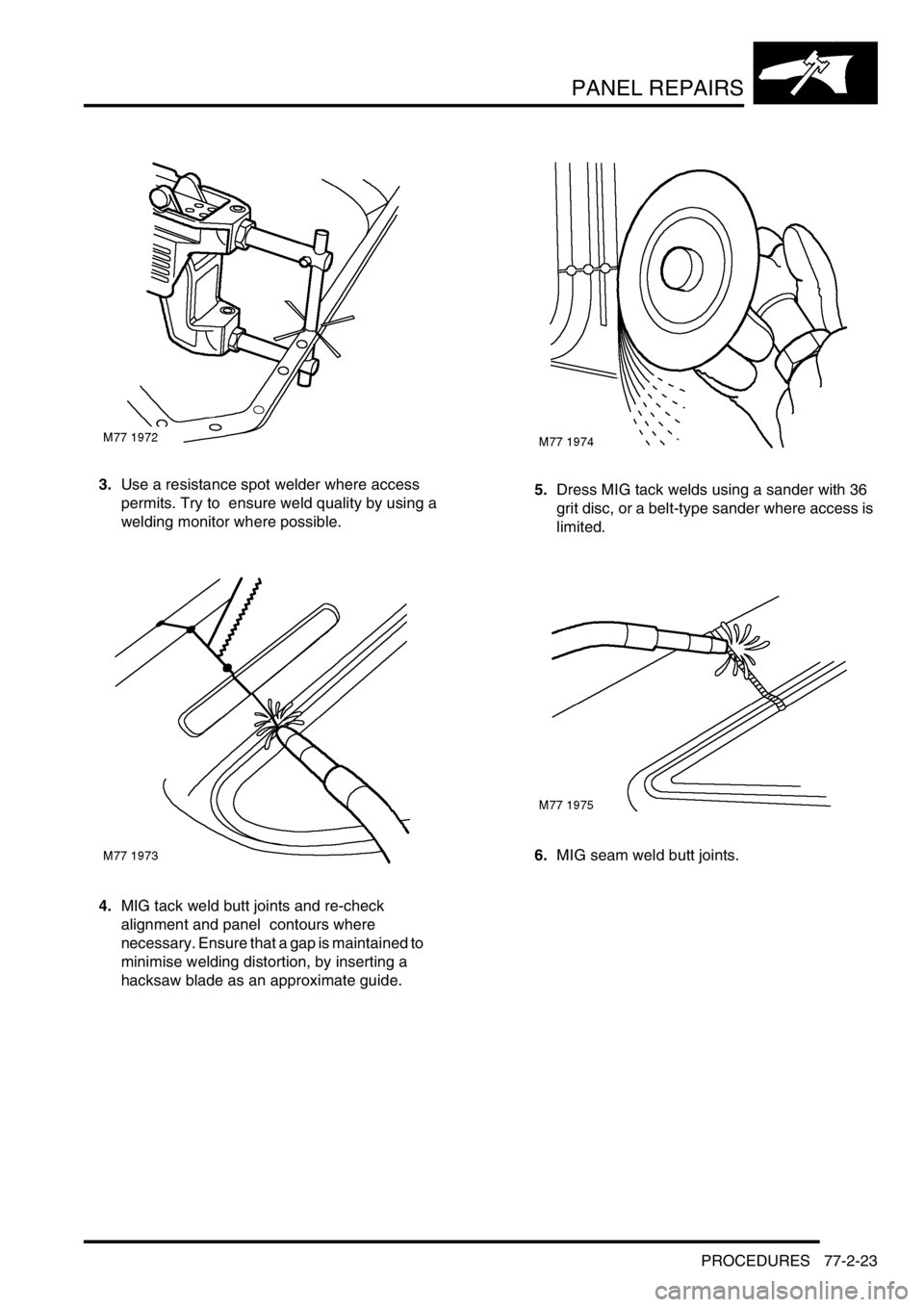
PANEL REPAIRS
PROCEDURES 77-2-23
3.Use a resistance spot welder where access
permits. Try to ensure weld quality by using a
welding monitor where possible.
4.MIG tack weld butt joints and re-check
alignment and panel contours where
necessary. Ensure that a gap is maintained to
minimise welding distortion, by inserting a
hacksaw blade as an approximate guide.5.Dress MIG tack welds using a sander with 36
grit disc, or a belt-type sander where access is
limited.
6.MIG seam weld butt joints.
Page 779 of 1007
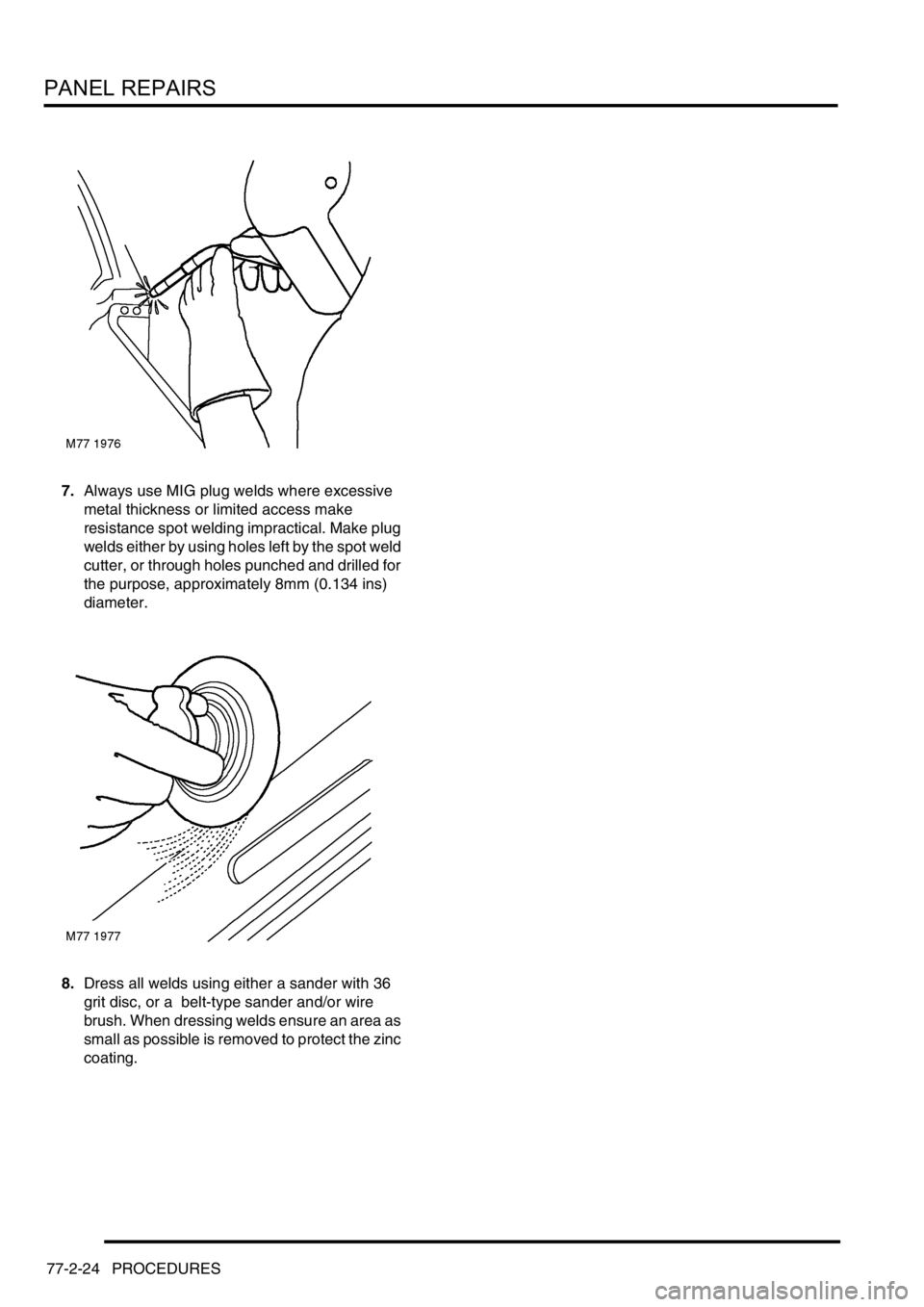
PANEL REPAIRS
77-2-24 PROCEDURES
7.Always use MIG plug welds where excessive
metal thickness or limited access make
resistance spot welding impractical. Make plug
welds either by using holes left by the spot weld
cutter, or through holes punched and drilled for
the purpose, approximately 8mm (0.134 ins)
diameter.
8.Dress all welds using either a sander with 36
grit disc, or a belt-type sander and/or wire
brush. When dressing welds ensure an area as
small as possible is removed to protect the zinc
coating.
Page 780 of 1007
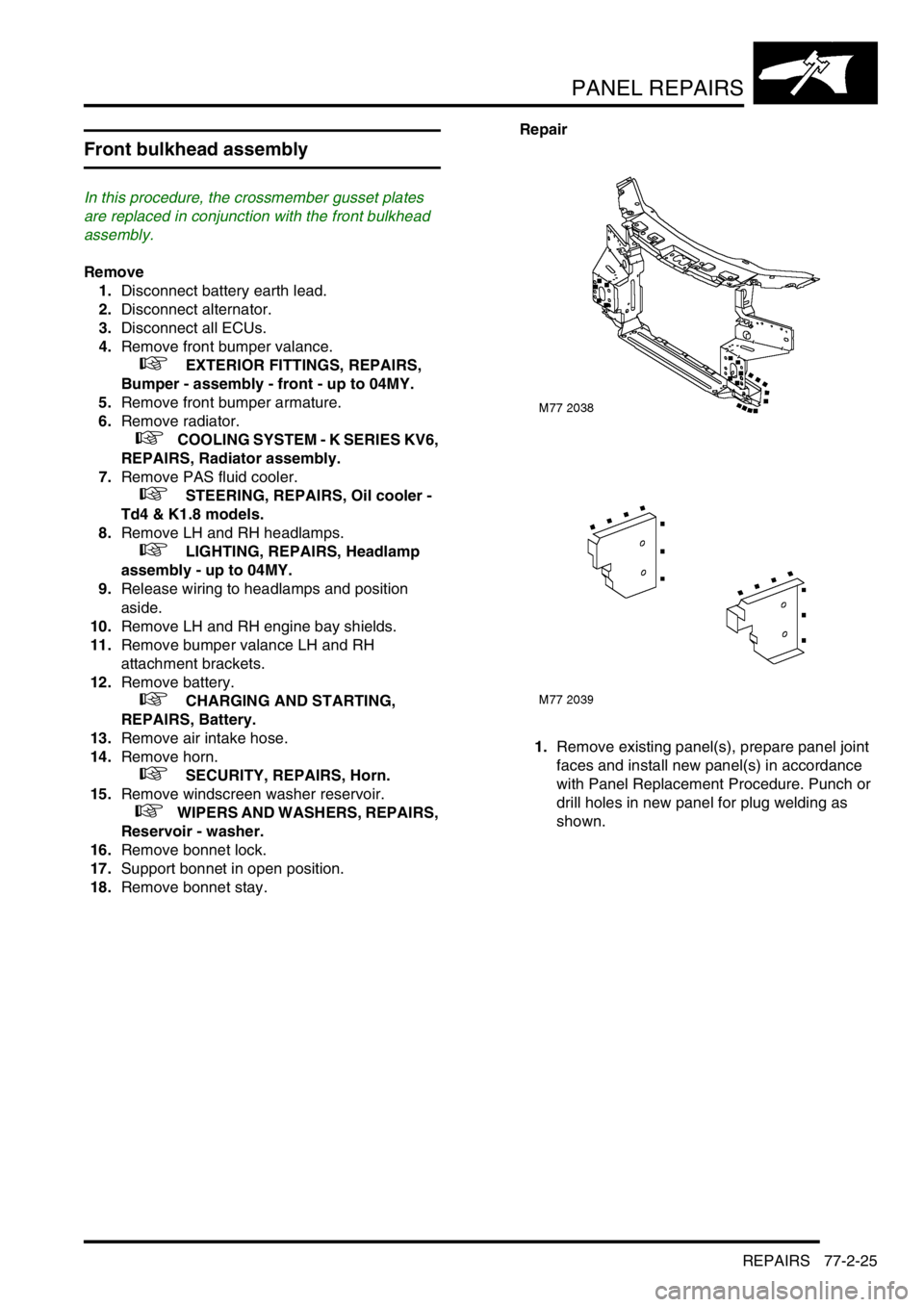
PANEL REPAIRS
REPAIRS 77-2-25
REPAIRS
Front bulkhead assembly
In this procedure, the crossmember gusset plates
are replaced in conjunction with the front bulkhead
assembly.
Remove
1.Disconnect battery earth lead.
2.Disconnect alternator.
3.Disconnect all ECUs.
4.Remove front bumper valance.
+ EXTERIOR FITTINGS, REPAIRS,
Bumper - assembly - front - up to 04MY.
5.Remove front bumper armature.
6.Remove radiator.
+ COOLING SYSTEM - K SERIES KV6,
REPAIRS, Radiator assembly.
7.Remove PAS fluid cooler.
+ STEERING, REPAIRS, Oil cooler -
Td4 & K1.8 models.
8.Remove LH and RH headlamps.
+ LIGHTING, REPAIRS, Headlamp
assembly - up to 04MY.
9.Release wiring to headlamps and position
aside.
10.Remove LH and RH engine bay shields.
11.Remove bumper valance LH and RH
attachment brackets.
12.Remove battery.
+ CHARGING AND STARTING,
REPAIRS, Battery.
13.Remove air intake hose.
14.Remove horn.
+ SECURITY, REPAIRS, Horn.
15.Remove windscreen washer reservoir.
+ WIPERS AND WASHERS, REPAIRS,
Reservoir - washer.
16.Remove bonnet lock.
17.Support bonnet in open position.
18.Remove bonnet stay. Repair
1.Remove existing panel(s), prepare panel joint
faces and install new panel(s) in accordance
with Panel Replacement Procedure. Punch or
drill holes in new panel for plug welding as
shown.